7.10.2022

PICTURES OF ALIENS IN USA, OCTOBER 1973
V.J. Ballester Olmos* and L. Ruiz Noguez**
(*) Spain. Corresponding author. E-mail: ballesterolmos@yahoo.es
(**) Mexico. Marcianitos verdes, https://marcianitosverdes.haaan.com/category/ovnis/
This note illustrates a fact already noticed in many countries and different times:
how mediatized cases influence one another in a concatenated way. Recently, our collaborator Kay Coggin, a non-stop seeker of UFO information in old press sources, found a photograph we had not seen previously.
The front page of Ohio’s Dayton Daily News of October 17, 1973 carried a picture credited to staff photographer Bill Shepard. The accompanying caption summarized the event well: “SILVER CLAD ‘HUMANOIDS’ LURK NEAR THEIR
BEAVERCREEK HOME. Pre-Halloween Prank Ended When Disbelieving Police Arrived.”

The newspaper’s writer Don Steward developed the story. His initial sentences are copied literally:
Three “humanoids” in silvery-white wrinkled skin, sprouting antennas and carrying a red blinking light, halted motorists along a desolate section of the U.S. 35 Xenia bypass late Tuesday [October 16] night. But it was nothing more than an early Halloween [October 31] prank perpetrated by Beavercreek township youths…Two of the youths were taken into custody without charges by Xenia police. They were identified as Mark K. Klentzman, 18, 2746 Edwin Drive in Beavercreek and Steven D. Lowe, 20, 3359 Sunnyside Drive, Dayton. Lowe identified the third youth, who eluded police, as Mark Stevens, 13, 1531N. Fairfield Rd., Beavercreek.
This event‒and the amazing shot‒received ample publicity. Walter Cronkite’s CBS Evening News of October 17 briefly reported on the Ohio police investigation of space creatures seen walking by the highway, with a crude “creatures arrested” ending the reportage.1 On the following day, the news was distributed widely across the nation, being printed in journals from Pennsylvania, Tennessee, New Jersey, Louisiana, Michigan, Massachusetts, Texas, and Georgia, at least that we have collected.2
Ideas never come out of the blue, and never was this truer than in the case of flying saucers. According to UFO lore, in 1973 the United States of America was under an intense wave of extraterrestrial spacecraft landings, with occupants showing blatantly. With 55 such cases registered in the country from August to December, 36 of them allegedly occurred in the month of October (nine in two single days, October 16-17!).3
This very joke had a very direct influence and was a consequence of the tale of a supposed abduction in Pascagoula (Mississippi), on October 11, 1973. On the night of that Thursday, two Walker Shipyard workers, Charles Hickson, 42, and Calvin Parker, 19, both of Gautier, were fishing on the west bank of the Pascagoula River, within sight of the two tollbooths and within reach of the security cameras at the Ingalls Shipyard, when they heard a buzzing sound
behind them. As they turned, they saw a bright egg-shaped object with two flashing blue lights on its front floating about 40 feet (12 m) above the river's edge. The object was about 30-40 feet (9-12 m) long and 8 feet (2.5 m) high.
Frozen with fear, the two men saw a door open and three creatures with leathery grey skin and crab-like claws floated over the river towards them. Two of the creatures captured Hickson and the third grabbed Parker who "passed out from fear," according to Hickson. Parker said he was conscious but paralyzed. "The creatures had legs but didn't use them," Hickson told The Mississippi Press in 1973." They were about 5 feet (1.5 m) tall, they had bullet heads without necks, slits for their mouths and where their noses or ears would be, they had thin, tapered objects sticking out, like carrots from a snowman's head. They had no eyes, gray and wrinkled skin, round fused legs ending in elephant legs, and claw hands. The creatures moved mechanically and robotically. They took them by the forearms and levitated them on board the spaceship.
Hickson claimed that inside the ship he somehow levitated or hovered a few feet above the ship's floor, where he was examined by what appeared to be a large mechanical eye in the shape of a soccer ball, 6 to 8 inches (15-20 cm) in diameter, which appeared to scan his body. "They gave me a thorough examination, like any doctor would," he recalled to a journalist 40 years later.4
Parker said that he could not remember what had happened to him inside the ship, although later, during certain medically-unguaranteed hypnotic regression sessions he was subjected to, he offered some confusing details. More than 20 years after the incident, he claimed that he was placed on a tilted table and examined by a "petite" being, evidently female. Although he was paralyzed, he was able to observe the being injecting a needle into the base of the lower part of his penis. The being then communicated with him telepathically, suggesting that he had been taken for a reason.
The men were released after about 20 minutes and the creatures levitated them back to their original positions on the river bank. The UFO was gone. Hickson said he needed three shots of liquor from a bottle in his car to calm his nerves before deciding whether to report what happened. They sat in their car for 45 minutes, trying to calm down. Thinking they would be ridiculed if they told anyone what had happened, Hickson and Parker initially decided to keep quiet. Finally, they decided to talk to Jackson County Sheriff Fred Diamond, who thought the men seemed sincere and really scared. Young Parker was especially disturbed. Hickson’s drinking whiskey admission and the fantastic story caused the Sheriff some doubts. Diamond and Captain Glenn Ryder interviewed the men, who then were left alone in a room which was equipped with a hidden microphone. For Ryder, they were genuinely scared.
As Hickson believed he had been subjected to radiation, they were then taken to Keesler AFB at Biloxi, where they were examined by several doctors. In the coming days, a polygraph test was made to Hickson. Parker refused. Later on, though, he passed a lie detector test he contracted himself. There are grounds to conclude that the tests were unreliably taken.5 The shipyard’s lawyer refused to have his clients tested by the very experienced Captain Charles Wimberly, head polygraph operator for the nearby Mobile Police Department. In any case, the validity of the lie detectors is severely questioned by the American Psychological Asssociation.6
Rolling Stone magazine reporter Joe Esterhas discovered that none of the guards who had been at the tollbooths and none of the operators saw anything that night. Nor did the surveillance cameras at the Ingalls shipyard record anything unusual.
The aftermath depositions of the two individuals took their story to an eerie limit. Parker claimed that he contacted the same ship again 19 years later. This time he voluntarily walked aboard the ship and encountered the same female being who had examined his body in 1973. He claimed that he had a conversation with the being, in English, in which she communicated a religious message to him. She informed him that they shared the same God, that the Bible was an authentic text and that her species wanted to live on Earth but could not because of humanity's tendency towards war and destruction. For his part. Hickson claimed in a book he coauthored that he was contacted by aliens three times after the abduction: in January 1974 at a local tree farm, in February 1974 at his home, and on Mother's Day 1974 in Mississippi.

“How they looked, this is how the 5-foot spacemen looked, according to Charles Hickson and Calvin Parker who said they were taken aboard a space craft. This drawing by Jim Flynt of Walker Shipyard was made as described by the men.” © The Mississippi Press Register.
As a matter of fact, the Pascagoula alleged close encounter with extraterrestrials began to be consumed by the local press on the next day, and it was on October 15th that it reached the TV news report7 and the first graphical representation of the Pascagoula entities was printed in the regular press.8 It is reasonable to think that this portrait robot induced the three Xenia-Beavercreek youths to concoct the joke on the night of October 16th, as a certain resemblance exists between the two images.
The Pascagoula abduction has accomplished wide propaganda in the UFO milieu since it broke the news. From the immediate log released by The Mississippi Press Register, with a collection of its own’s news clips published in the climax period of October 12th to 19th, a 13-page A-4 illustrated edition8, to books published hardly a few months later capitalizing on the October reports, like the 99-page booklet on Tennessee Valley UFOs,9 or straight on Pascagoula, as a Bantam paperback,10 up to books written by the abductees themselves.11,12 It also attracted critical appraisals, as could not be otherwise.5
Did the Xenia-Beavercreek picture inspire another major photography of a flying saucer pilot? We refer to the amazing encounter with a silver-suited man from space that Falkville, Alabama police officer Jeffrey Greenhaw had at around 10:45 p.m. on October 17, 1973. We know for sure it was the real date of the event (i.e., not backdated), as chief Greenhaw called the local newspaper at 11:30 p.m. that night to report the incident, and it was posted in the front page of The Decatur Daily on the following day.13 Before we attempt to determine the interdependence of these cases, let us briefly summarize this last alien encounter.
It was just after 10 p.m. on October 17, 1973, when policeman Jeffrey Greenhaw, of Falkville, Alabama, was resting in his home. Suddenly the phone rang. It was an emergency call. On the other end, a neighbor whom the policeman knew very well reported that she had just seen a flying saucer land with flashing lights in a meadow west of the city. Greenhaw, 26, was off duty at the time, but decided to go to investigate. He jumped out of his seat and ran to his vehicle, the official radio patrol car. Within minutes, he showed up at the spot where the lady said she saw the UFO land and conducted an eye inspection: the ground was clear and there was absolutely nothing unusual there. He got into the car again and drove along the road a little bit, until he came to a left route, gravelly and narrow. He entered the road, paying close attention to what might be on either side of the road, illuminated by the vehicle's headlights. A few hundred meters ahead, he saw a man standing in the middle of the road. He was about the size of an adult
human being. He stopped the car, got out to ask him who he was and if he could help him with anything. No reply.
The figure was dimly (indirectly) illuminated by the car's headlights and it was approaching to the policeman, slowly, walking awkwardly. He then noticed that the figure was dressed in a metallic-looking overall, with his head covered with a helmet. An antenna seemed to sprout from the top of it. Greenhaw took his Polaroid camera and made four snapshots.
He turned on the rotating light of his car and the strange being stopped for a moment, as if bewildered. Then the figure turned and ran "faster than any human I have ever seen." The police officer tried to chase the creature, but his abrupt acceleration made the car skid into the ditch. When he regained control of the car and got back on the road the figure had vanished.14
According to his testimony, Greenhaw saw the entity when it was at about 50 feet (15 m), grabbed his Polaroid camera from his car and took one picture of the entity from 40-50 feet (~14 m), another from 30-40 feet (~11 m) and two last from 10 feet (~3 m).15 Concerning the fate of the instant pictures, two different sources state that the original prints were destroyed in the fire that gutted the policeman’s trailer home on November 9, but Huntsville’s ufologist Warren E. York photographed them before the evidence was totally lost.16,17 On the other hand, the four pictures we are showing here come from “miniature copy negatives of the originals” in possession of ICUFON.18
NICAP, the non-skeptically-oriented, leading US UFO organization then, had major field investigator Marion Webb studying the case as soon as it was publicized. After three years of investigation, it concluded that “The analysis
revealed that the garment of the alleged creature is a hot suit, manufactured from fire retardant materials, then coated with aluminum covering.”19 Likewise, in the opinion of other independent investigators, “the creature is an adult human mostly wrapped up in aluminum foil.”17


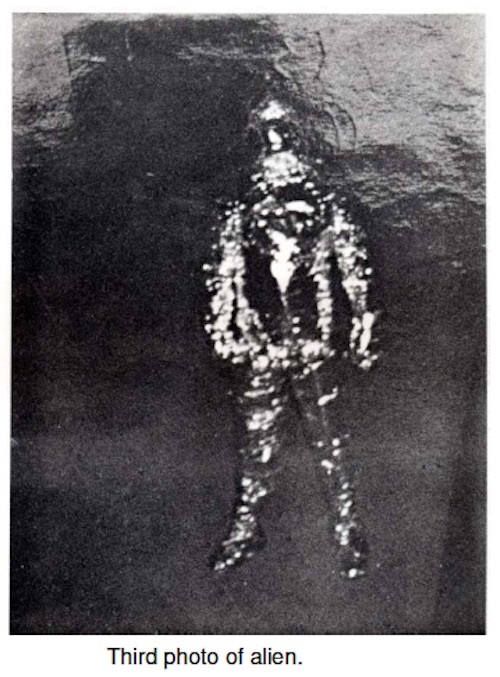

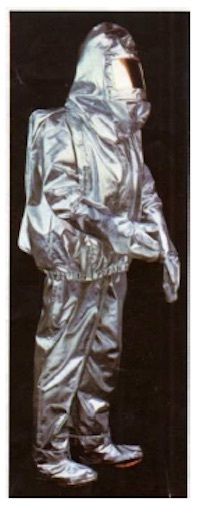
In our files we have examples of similar-looking fire-protecting equipment that, disguised in the night and pictured with a Polaroid camera, would very much resemble the Alabama entity.
The question now is: was it a joke played on the young (23) police officer, or was he involved in the theater? In a response to the Letters to the Editor section, NICAP president John Acuff also pointed explicitly: “The Greenhaw case is a hoax. This hoax has been admitted by one of the participants.”20 But there is more detail to this statement. In a private letter to the noteworthy American UFO researcher Richard Heiden, Acuff added this: “The omission of the confessor’s name in the Greenhaw case was deliberate. The person in question is a minor who worked with Greenhaw on the hoax and we felt that because of his age (17) that we should not publish his name. The boy is the one who dressed as a humanoid.”21
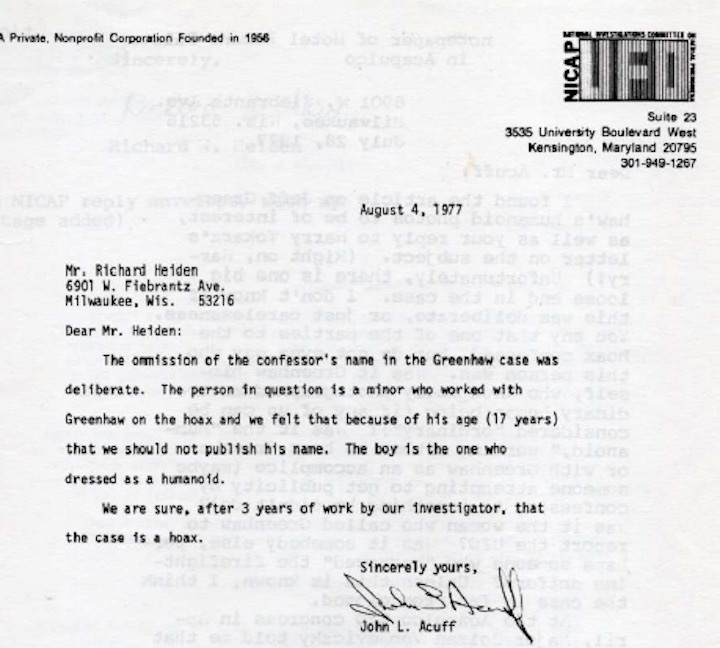
Ground saucer Watch, an organization specializing in computer image enhancement22 of UFO photographs very active in the 1970s-80s, did analyze the Falkville prints. Its technical study concluded that the photographs “represent a humorous attempt at hoaxing a space creature.”23 It was another prank; this is beyond question. But what stimulated it? We established a chronology of the three occurrences:
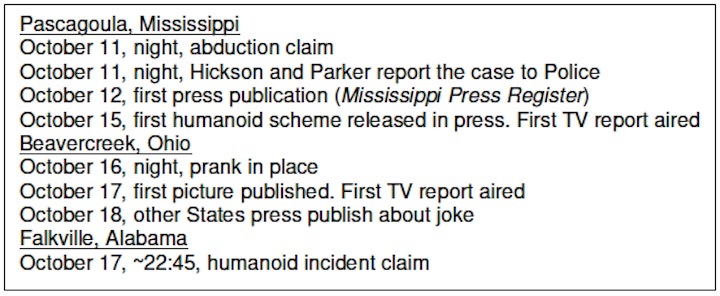
Although one might believe there is a direct relationship between Beavercreek and Falkville, knowing that the last case’s date is actual, then we have to infer that both tales and happenings derived from the publicity given to the Pascagoula abduction case, a fabrication itself.
As stated before, the distribution of the fall 1973 of “humanoid” reports had a climax in October. The spread of 54 US reports of this kind is concentrated in one single month. Why? The reply seems quite evident if we look at the plot of 32 October reports by two-day periods. The Pascagoula abduction (October 11) figures prominently as the fueling point for following narratives. With the passing of time, we now know that these were just imaginative, inconsequential stories prompted by the media exposure to the Pascagoula affair.


Just a couple of those entity sighting reports had photographic evidence. Both are recognized pranks. One (Falkville) got international attention, especially in UFO journals and books. Not in vain, it has been graded as “the second most famous UFO-abduction case in history.”24 Another (Beavercreek) had a low profile, only in terms of national press consumption. This article has reviewed both cases in their connection to the Pascagoula temporary kidnapping, that hit the news a few days before.
This brief note gives us an opportunity to explore somewhat the magnitude of the 1973 UFO wave of UFO landings and their spacemen crews in the United States. As UFO waves sociologically and mediately behave, the intensity of the reporting recrudescence reaches a saturation point and then more or less sharply declines toward average or background figures, the time amplitude of the wave depending of the promotion it receives in press and TV.
In order to measure the impact of the UFO wave in the context of surrounding years, both nationally and internationally, we have resorted to the largest database of UFO landing reports, the over 5,000-case Peter Rogerson’s INTCAT.25
The following chart shows numbers of reports of UFO touchdowns from 1971 to 1975 in the United States of America, side by side with the rest of the world panorama. Immediately, it is realized the quantified hit of the US 1973 wave (362reports) at worldwide level, with an effect of 172% over the sum of similar cases in the rest of the countries (only 210 reports). A paramount figure. Yet the second evident feature we discover is how “UFO landings” are typically an American product. In the set of the five years reviewed (Σ828 US, Σ1069 all others), flying saucer disembarkations in the US amount to 4 out of 5 such stories in the planet. Even more, when you go through the succession of reports in the Rogerson catalog, you discover that most of the ensuing reports come from Englishspeaking countries like United Kingdom, Australia, or Canada, natural beneficiaries of the American culture and mythologies.

The specificity of tales of landings and related entities as an American (then, Anglo-Saxon) influence is apparent when you plot another type of global UFO data, the events where UFOs were photographed. We have tallied FOTOCAT’s database26 for the same period (1971-1975), divided by USA (Σ192 entries) and rest of the world (Σ891 entries). Here, not only is the effect of the 1973 spike much softer, but the statistical structure of the incoming reports is totally different. Are Americans more prone to (non-censurable) spin tales than to (appraisable)
photography?
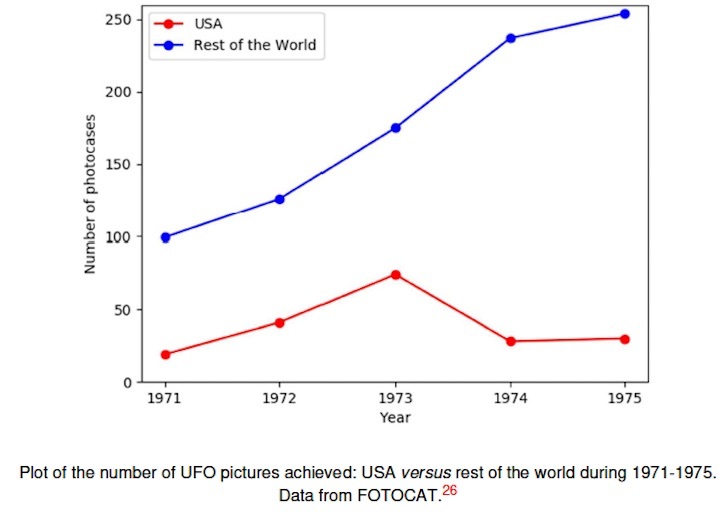
Be that as it may, the essential need for a social study of “flaps” and “waves” in UFO reporting27,28 runs parallel to the imperative need of research into the few significant UFO events that still remain unidentified.
+
References
(1) https://www.youtube.com/watch?v=My3D5M2bval
(2) A sample of other press items delivering the humanoid prank news: Evening
Herald (Shenandoah, Pennsylvania), October 18, 1973. Knoxville News-Sentinel
(Knoxville, Tennessee), Galesburg Register-Mail (Illinois), The Tennessean
(Nashville), The Record (Hackensack, New Jersey), Advocate (Baton Rouge,
Louisiana), Marietta Journal, San Antonio Light (San Antonio, Texas), all for
October 18, 1973. South Haven Daily Tribune, October 22, 1973.
(3) David Webb, 1973-Year of the Humanoids, 2nd edition, Center for UFO
Studies (Evanston, Illinois), May 1976.
(4) Jeff Amy, https://apnews.com/56d45e5966324e7d968e50b4ac94f908
(5) Philip J. Klass, “’Abduction’ in Pascagoula,” in UFOs Explained, Random
House (New York), 1974, pages 293-311.
(6) https://www.apa.org/research/action/polygraph
(7) Kenly Jones, reporter, https://tvnews.vanderbilt.edu/broadcasts/467241
(8) The Mississippi Press Register, UFOs Over Mississippi…A 7-Day Space
Odyssey, Mississippi Press (Pascagoula), 1973.
(9) W.A. Darbro & Stanley L. Ingram, Unidentified Flying Objects over the
Tennessee Valley, South Publishing Co. (Huntsville, Alabama), 1974.
(10) Ralph Blum with Judy Blum, Beyond Earth: Man’s Contact with UFOs,
Bantam Books (New York), April 1974.
(11) Charles Hickson & William Mendez, UFO Contact at Pascagoula, Wendelle
C. Stevens (Tucson, Arizona), 1983.
(12) Calvin Parker, Pascagoula – The Story Continues, Flying Disk Press (UK),
September 2019, https://www.amazon.com/dp/1688698620
(13) The Decatur Daily, October 18, 1973, pages 1 and 8,
https://newspaperarchive.com/other-articles-clipping-oct-18-1973-1538461/ and
https://newspaperarchive.com/other-articles-clipping-oct-18-1973-1538464/ And
October 19, 1973, page 10,
https://newspaperarchive.com/other-articles-clipping-oct-19-1973-1538243/
(14) Luis Ruiz Noguez, “El robot de Falkville,“ in Extraterrestres ante las cámaras.
Volumen VII (Lulu), 2010, pages 69-121, http://www.lulu.com/shop/luis-ruiznoguez/
extraterrestres-ante-las-c%C3%A1maras-volumenvii/
paperback/product-13585635.html
(15) Colman VonKeviczky & Karl L. Veit, “Police Chief Jeffrey Greenhaw of
Falkville (Ala.) Encounter with an Extraterrestrial Entity,” 1974. Official UFO,
August 1975, pages 20-27 & 52-54.
(16) Warren Smith, SAGA, October 1974, page 48.
(17) Walt Greenawald, letter to NICAP, December 10, 1974.
(18) Colman S. VonKeviczky, letter to Vicente-Juan Ballester Olmos, September
18, 1975. Photographs submitted to VJBO on October 11, 1975.
(19) UFO Investigator, January 1977, page 4.
(20) John L. Acuff, “Response,” UFO Investigator, April 1977, page 4.
(21) John L. Acuff, letter to Richard W. Heiden, August 4, 1977.
(22) William H. Spaulding & Fred Adrian, “Usage of Computer Photographic
Evaluation Techniques,” UPIAR Research in Progress, Vol. I, No. 1, 1982, pages
11-22, http://cdufo.info/tra/tra00008.pdf
(23) William Spaulding, “Falkville Creature Photographs Analyzed,” The MUFON
UFO Journal, November 1976, cover and pages 3-5.
(24) Jerome Clark, High Strangeness: UFOs from 1969 through 1979 (The UFO
Encyclopedia, Volume 3), Omnigraphics (Detroit, Michigan), 1996, pages 389-396.
(25) Peter Rogerson, INTCAT, International catalogue of close encounters and
entity reports, 1752-1986, http://intcat.blogspot.com/
(26) Based in Valencia (Spain), FOTOCAT is an Excel-spreadsheet-formatted
worldwide catalog of over 12,500 UFO events with a photographic record,
generally up to yearend 2005, http://fotocat.blogspot.com/
(27) Vicente-Juan Ballester Olmos, “UFO Waves: An International Bibliography,”
http://www.cnesgeipan.
fr/typo3conf/ext/dam_frontend/pushfile.php?docID=11383
(28) Vicente-Juan Ballester Olmos, “The UFO Waves Review Project,”
https://www.academia.edu/19729160/The_UFO_Waves_Review_Project
Acknowledgments
To Martin Shough, for editing. To Kay Coggin, for newspaper research. To Julio
Plaza del Olmo for technical assistance. To Matías Morey. To Dr. Mark Rodeghier
(J.A. Hynek CUFOS).
Quelle: V.J. Ballester Olmos* and L. Ruiz Noguez**
